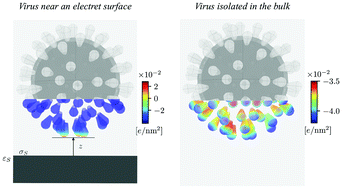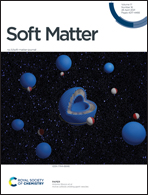Electrostatic interactions between the SARS-CoV-2 virus and a charged electret fibre†
Abstract
While almost any kind of face mask offers some protection against particles and pathogens of different sizes, the most efficient ones make use of a layered structure where one or more layers are electrically charged. These electret layers are essential for the efficient filtration of difficult-to-capture small particles, yet the exact nature of electrostatic capture with respect to the charge on both the particles and the electret fibres as well as the effect of the immediate environment remain unclear. Here, we explore in detail the electrostatic interactions between the surface of a single charged electret fibre and a model of the SARS-CoV-2 virus. Using Poisson–Boltzmann electrostatics coupled to a detailed spike protein charge regulation model, we show how pH and salt concentration drastically change both the scale and the sign of the interaction. Furthermore, the configuration of the few spike proteins closest to the electret fibre turns out to be as important for the strength of the interaction as their total number on the virus envelope, a direct consequence of spike protein charge regulation. The results of our work elucidate the details of virus electrostatics and contribute to the general understanding of efficient virus filtration mechanisms.

- This article is part of the themed collection: Coronavirus articles - free to access collection


 Please wait while we load your content...
Please wait while we load your content...